
The Cathedral of the Blessed Virgin Mary is a Church of England cathedral in the city of Truro, Cornwall. It was built between 1880 and 1910 to a Gothic Revival design by John Loughborough Pearson on the site of the parish church of St Mary. It is one of only three cathedrals in the United Kingdom featuring three spires.
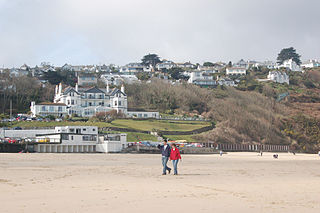
Carbis Bay is a seaside resort and village in Cornwall, England. It lies 1 mile (1.6 km) southeast of St Ives, on the western coast of St Ives Bay, on the Atlantic coast. The South West Coast Path passes above the beach.

St Erth is a civil parish and village in Cornwall, England.

Towednack is a churchtown and civil parish in Cornwall, England, United Kingdom. The parish is bounded by those of Zennor in the west, Gulval in the south, Ludgvan in the west and south, and St Ives and the Atlantic Ocean in the north and east. The church is about two miles (3 km) from St Ives and six miles (10 km) from Penzance.

Sancreed is a village and civil parish in Cornwall, England, approximately three miles (5 km) west of Penzance.
Feock is a coastal civil parish and village in Cornwall, England, United Kingdom. It is about 5 miles (8.0 km) south of Truro at the head of Carrick Roads on the River Fal. To the south, the parish is bordered by Restronguet Creek and to the east by Carrick Roads and the River Fal. To the north it is bordered by Kea parish and to the west by Perranarworthal parish.

Lelant is a village in west Cornwall, England, UK. It is on the west side of the Hayle Estuary, about 2+1⁄2 miles (4.0 km) southeast of St Ives and one mile (1.6 km) west of Hayle. The village is part of St Ives civil parish, the Lelant and Carbis Bay ward on Cornwall Council, and also the St Ives Parliamentary constituency. The birth, marriage, and death registration district is Penzance. Its population at the 2011 census was 3,892 The South West Coast Path, which follows the coast of south west England from Somerset to Dorset passes through Lelant, along the estuary and above Porth Kidney Sands.

Crowan is a village and civil parish in Cornwall, United Kingdom. It is about three-and-a-half miles (6 km) south of Camborne. A former mining parish, all of the mines had shut by 1880.

Sithney is a village and civil parish in West Cornwall, England, United Kingdom. Sithney is north of Porthleven. The population including Boscadjack and Crowntown at the 2011 census was 841.

Lanivet is a village and civil parish in Cornwall, England, United Kingdom. The village is situated approximately 2+1⁄2 miles (4.0 km) southwest of Bodmin, and before the Bodmin by-pass was built, the A30 road between London and Land's End passed through the village. The Saints' Way long-distance footpath passes Lanivet near its half-way point.

St Bridget's Church, Morvah is a parish church in the Church of England Diocese of Truro located in Morvah, Cornwall, UK. It was licensed for divine service by the Bishop of Exeter on 22 September 1400. The tower is the only remaining medieval part of the church. The nave and chancel were rebuilt in 1828. The church was added to the National Heritage List for England in 1954 at grade II, the lowest of three grades for listed buildings.

St Just in Penwith Parish Church is a parish church in the Church of England located in St Just in Penwith, Cornwall, UK.

St Ia's Church, St Ives, is a parish church in the Church of England in St Ives, Cornwall, UK. It is dedicated to Ia of Cornwall, a 5th- or 6th-century Irish saint, and is a Grade I listed building.

St Maddern's Church is the parish church of Madron, near Penzance in Cornwall and was once the mother church of Morvah and Penzance. It is a Grade I listed building.
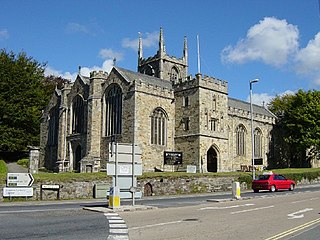
St Petroc's Church, Bodmin, also known as Bodmin Parish Church, was a Roman Catholic Church until the reformation and is currently an Anglican parish church in the town of Bodmin, Cornwall, England, United Kingdom.
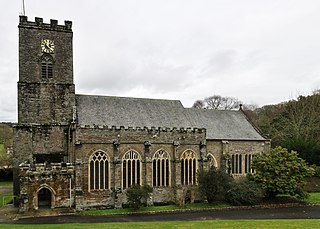
Christianity in Cornwall began in the 4th or 5th century AD when Western Christianity was introduced as in the rest of Roman Britain. Over time it became the official religion, superseding previous Celtic and Roman practices. Early Christianity in Cornwall was spread largely by the saints, including Saint Piran, the patron of the county. Cornwall, like other parts of Britain, is sometimes associated with the distinct collection of practices known as Celtic Christianity but was always in communion with the wider Catholic Church. The Cornish saints are commemorated in legends, churches and placenames.
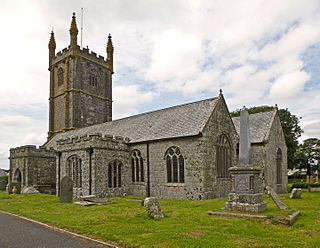
Breage Parish Church is the Anglican parish church of the parish of Breage, Cornwall, England, United Kingdom. It is dedicated to Saint Breage or Breaca, said to have been an Irish nun who came to Cornwall in the 5th-century.
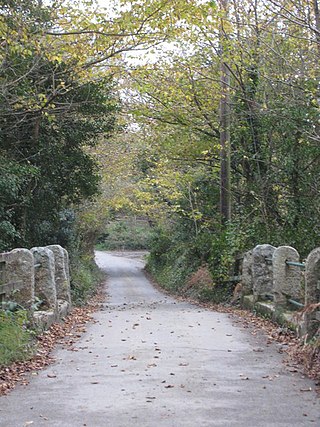
Menadarva is a hamlet in the parish of Camborne, Cornwall, England, UK. The Red River flows through the hamlet and on 9 March 1885 the machinery and materials of the Menadarva Lower Tin-Stream was put up for auction.

St Gwinear's Church, Gwinear is a Grade I listed church in the Church of England in Gwinear, Cornwall.

All Saints’ Church, Tuckingmill is a Grade II listed parish church in the Church of England in Pendarves Street, Tuckingmill, Camborne, Cornwall.






















